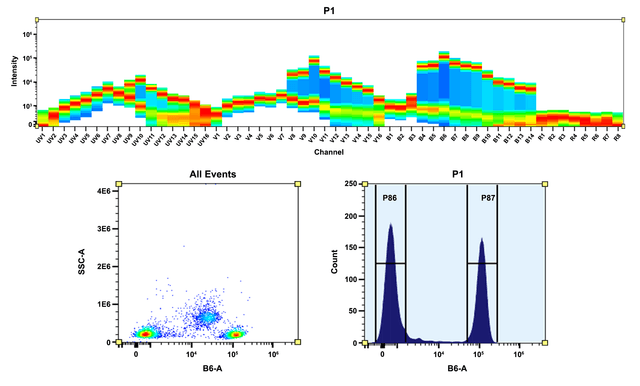PE [R-Phycoerythrin] *CAS 11016-17-4*
Ordering information
| Price | |
| Catalog Number | |
| Unit Size | |
| Quantity |
Additional ordering information
| Telephone | 1-800-990-8053 |
| Fax | 1-800-609-2943 |
| sales@aatbio.com | |
| International | See distributors |
| Bulk request | Inquire |
| Custom size | Inquire |
| Shipping | Standard overnight for United States, inquire for international |
Physical properties
| Molecular weight | ~240000 |
| Solvent | Water |
Spectral properties
| Correction Factor (280 nm) | 0.175 |
| Extinction coefficient (cm -1 M -1) | 1960000 |
| Excitation (nm) | 565 |
| Emission (nm) | 574 |
| Quantum yield | 0.82 |
Storage, safety and handling
| Certificate of Origin | Download PDF |
| H-phrase | H303, H313, H333 |
| Hazard symbol | XN |
| Intended use | Research Use Only (RUO) |
| R-phrase | R20, R21, R22 |
| Storage | Refrigerated (2-8 °C); Minimize light exposure |
| UNSPSC | 12171501 |
| Overview |
See also: PE and APC, Spectral Flow Cytometry
CAS 11016-17-4 | Molecular weight ~240000 | Correction Factor (280 nm) 0.175 | Extinction coefficient (cm -1 M -1) 1960000 | Excitation (nm) 565 | Emission (nm) 574 | Quantum yield 0.82 |
R-Phycoerythrin (PE) is isolated from red algae. Its primary absorption peak is at 565 nm with secondary peaks at 496 and 545 nm. The relative prominence of the secondary peaks varies significantly among R-PEs from different species. PE has three types of subunits: alpha (20,000 daltons), beta (20,000 daltons) and gamma (30,000 daltons). The molecular weight of intact PE has been found to be about 240,000 daltons. The alpha subunit of PE contains only the phycoerythrobilin (PEB) chromophore, while beta and gamma subunits contain both PEB and phycourobilin (PUB). Variability in the absorption spectra of PEs from various species reflects differences in the PEB/PUB ratio of the subunits. PE and closely related B-PE are the most intensely fluorescent phycobiliproteins, with quantum efficiencies probably in excess of 90%, and its orange fluorescence is readily visible by eye in any moderately concentrated solution.
Spectrum
Open in Advanced Spectrum Viewer
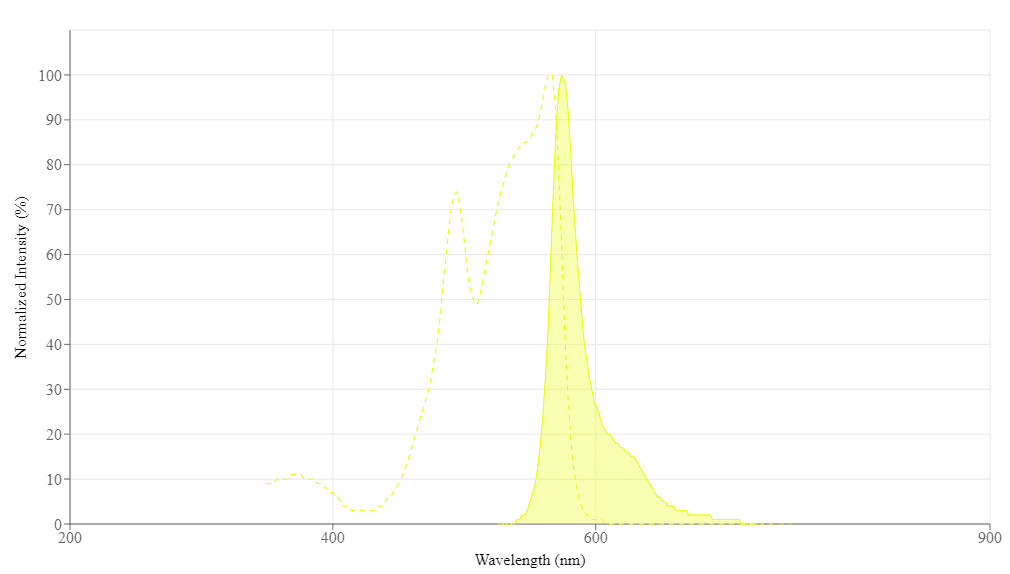

Spectral properties
| Correction Factor (280 nm) | 0.175 |
| Extinction coefficient (cm -1 M -1) | 1960000 |
| Excitation (nm) | 565 |
| Emission (nm) | 574 |
| Quantum yield | 0.82 |
Images
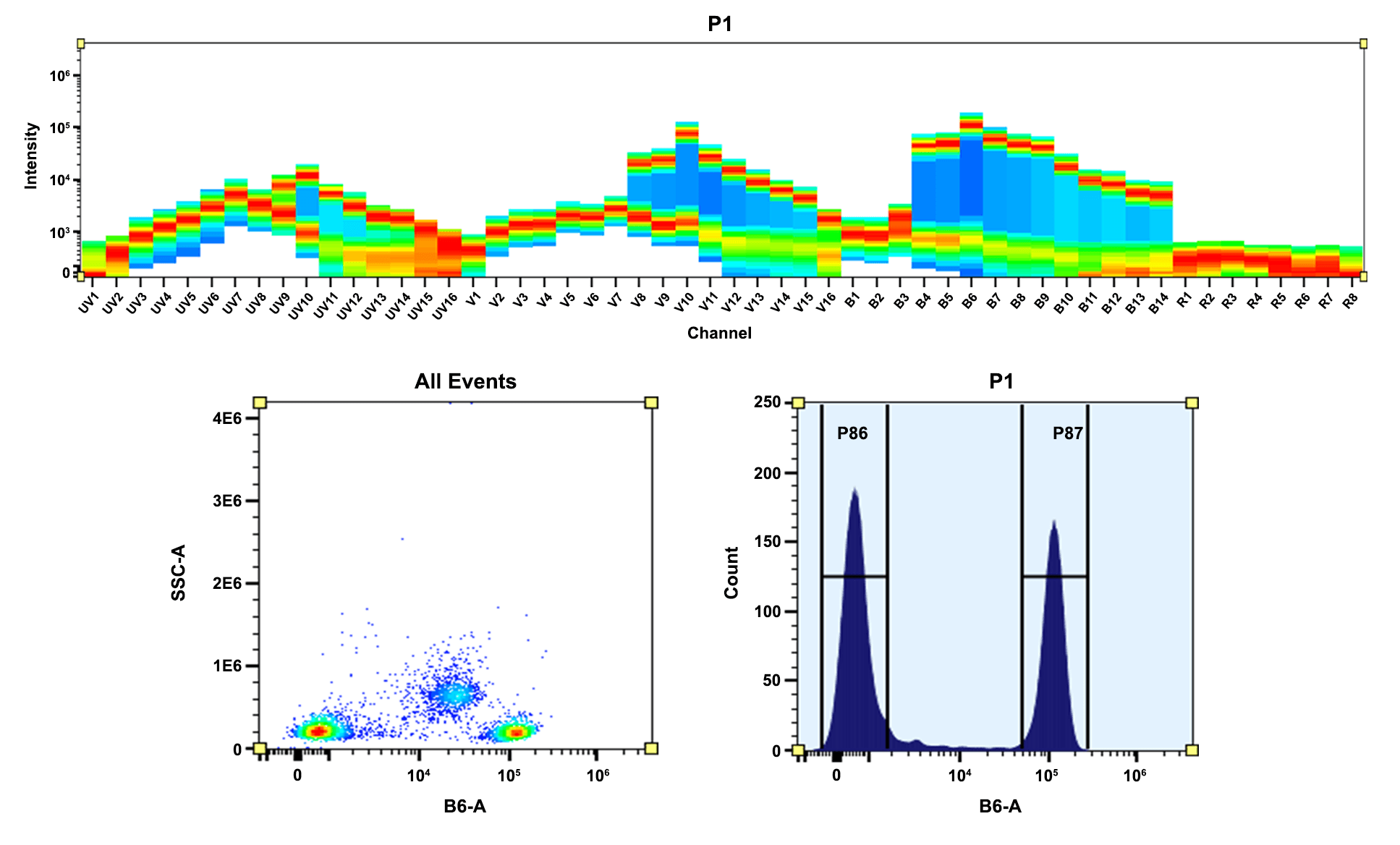
Figure 1. Top) Spectral pattern was generated using a 4-laser spectral cytometer. Spatially offset lasers (355 nm, 405 nm, 488 nm, and 640 nm) were used to create four distinct emission profiles, then, when combined, yielded the overall spectral signature. Bottom) Flow cytometry analysis of PBMC stained with PE anti-human CD4 *SK3* conjugate. The fluorescence signal was monitored using an Aurora spectral flow cytometer in the PE specific B6-A channel.
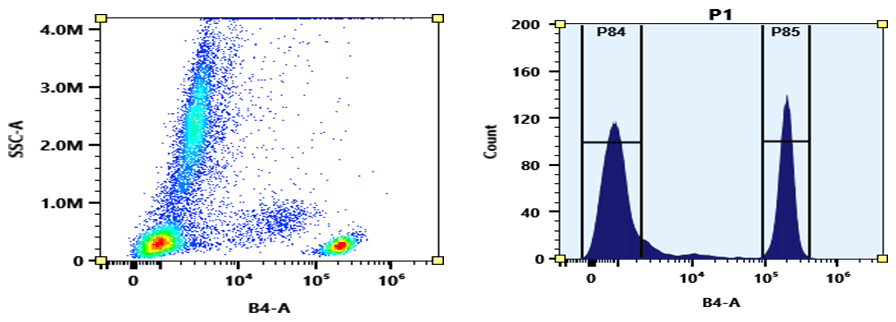
Figure 2. Flow cytometry analysis of whole blood stained with PE anti-human CD4 *SK3* conjugate. The fluorescence signal was monitored using an Aurora spectral flow cytometer in the PE specific B4-A channel.
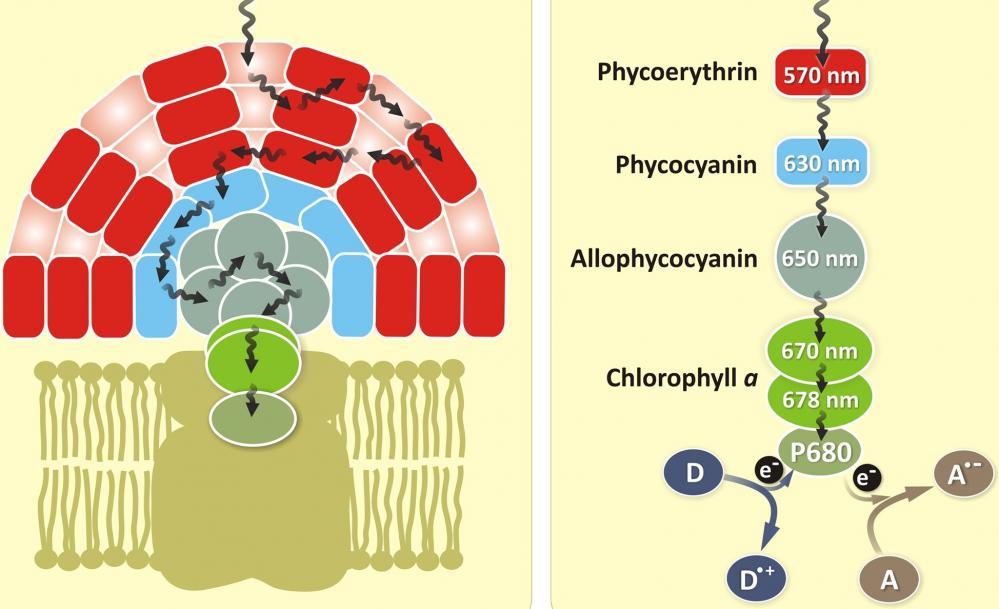
Figure 3. Phycoerythrin (PE) is a red protein-pigment complex from the light harvesting phycobiliprotein family, present in red algae and cryptophytes, accessory to the main chlorophyll pigments responsible for photosynthesis. Like all phycobiliproteins, it is composed of a protein part covalently binding chromophores called phycobilins. In the phycoerythrin family, the most known phycobilins are: phycoerythrobilin, the typical phycoerythrin acceptor chromophore, and sometimes phycourobilin. Phycoerythrins are composed of (αβ) monomers, usually organized in a disk-shaped trimer (αβ)3 or hexamer (αβ)6 (second one is the functional unit of the antenna rods). These typical complexes also contain a third type of subunit, the γ chain. Phycobilin pigments have excellent fluorescent properties that are extremely useful for flow cytometry-based immunoassays.
Citations
View all 5 citations: Citation Explorer
Targeting pro-inflammatory T cells as a novel therapeutic approach to potentially resolve atherosclerosis in humans
Authors: Fan, Lin and Liu, Junwei and Hu, Wei and Chen, Zexin and Lan, Jie and Zhang, Tongtong and Zhang, Yang and Wu, Xianpeng and Zhong, Zhiwei and Zhang, Danyang and others,
Journal: Cell Research (2024): 1--21
Authors: Fan, Lin and Liu, Junwei and Hu, Wei and Chen, Zexin and Lan, Jie and Zhang, Tongtong and Zhang, Yang and Wu, Xianpeng and Zhong, Zhiwei and Zhang, Danyang and others,
Journal: Cell Research (2024): 1--21
Direct Cytosolic Delivery of Proteins and CRISPR-Cas9 Genome Editing by Gemini Amphiphiles via Non-Endocytic Translocation Pathways
Authors: Le, Zhicheng and Pan, Qi and He, Zepeng and Liu, Hong and Shi, Yi and Liu, Lixin and Liu, Zhijia and Ping, Yuan and Chen, Yongming
Journal: ACS Central Science (2023)
Authors: Le, Zhicheng and Pan, Qi and He, Zepeng and Liu, Hong and Shi, Yi and Liu, Lixin and Liu, Zhijia and Ping, Yuan and Chen, Yongming
Journal: ACS Central Science (2023)
CD169+ subcapsular sinus macrophage-derived microvesicles are associated with light zone follicular dendritic cells
Authors: Chen, Xin and Zheng, Yuhan and Liu, Siming and Yu, Wenjing and Liu, Zhiduo
Journal: European Journal of Immunology (2022): 1581--1594
Authors: Chen, Xin and Zheng, Yuhan and Liu, Siming and Yu, Wenjing and Liu, Zhiduo
Journal: European Journal of Immunology (2022): 1581--1594
Nanobubbles Containing sPD-1 and Ce6 Mediate Combination Immunotherapy and Suppress Hepatocellular Carcinoma in Mice
Authors: Tan, Yandi and Yang, Shiqi and Ma, Yao and Li, Jinlin and Xie, Qian and Liu, Chaoqi and Zhao, Yun
Journal: International Journal of Nanomedicine (2021): 3241
Authors: Tan, Yandi and Yang, Shiqi and Ma, Yao and Li, Jinlin and Xie, Qian and Liu, Chaoqi and Zhao, Yun
Journal: International Journal of Nanomedicine (2021): 3241
Morphological Changes Induced By Extremely Low-Frequency Electric Fields
Authors: Imani, Mahdi and Kazemi, Sepide and Saviz, Mehrdad and Farahm, undefined and , Leila and Sadeghi, Behnam and Faraji-dana, Reza
Journal: Bioelectromagnetics (2019)
Authors: Imani, Mahdi and Kazemi, Sepide and Saviz, Mehrdad and Farahm, undefined and , Leila and Sadeghi, Behnam and Faraji-dana, Reza
Journal: Bioelectromagnetics (2019)
References
View all 46 references: Citation Explorer
Chromophore attachment to phycobiliprotein beta-subunits: phycocyanobilin:cysteine-beta84 phycobiliprotein lyase activity of CpeS-like protein from Anabaena Sp. PCC7120
Authors: Zhao KH, Su P, Li J, Tu JM, Zhou M, Bubenzer C, Scheer H.
Journal: J Biol Chem (2006): 8573
Authors: Zhao KH, Su P, Li J, Tu JM, Zhou M, Bubenzer C, Scheer H.
Journal: J Biol Chem (2006): 8573
Excitation energy transfer from phycobiliprotein to chlorophyll d in intact cells of Acaryochloris marina studied by time- and wavelength-resolved fluorescence spectroscopy
Authors: Petrasek Z, Schmitt FJ, Theiss C, Huyer J, Chen M, Larkum A, Eichler HJ, Kemnitz K, Eckert HJ.
Journal: Photochem Photobiol Sci (2005): 1016
Authors: Petrasek Z, Schmitt FJ, Theiss C, Huyer J, Chen M, Larkum A, Eichler HJ, Kemnitz K, Eckert HJ.
Journal: Photochem Photobiol Sci (2005): 1016
Single-molecule spectroscopy selectively probes donor and acceptor chromophores in the phycobiliprotein allophycocyanin
Authors: Loos D, Cotlet M, De Schryver F, Habuchi S, Hofkens J.
Journal: Biophys J (2004): 2598
Authors: Loos D, Cotlet M, De Schryver F, Habuchi S, Hofkens J.
Journal: Biophys J (2004): 2598
Isolation and characterisation of phycobiliprotein rich mutant of cyanobacterium Synechocystis sp
Authors: Prasanna R, Dhar DW, Dominic TK, Tiwari ON, Singh PK.
Journal: Acta Biol Hung (2003): 113
Authors: Prasanna R, Dhar DW, Dominic TK, Tiwari ON, Singh PK.
Journal: Acta Biol Hung (2003): 113
Evaluation of Tolypothrix germplasm for phycobiliprotein content
Authors: Prasanna R, Prasanna BM, Mohammadi SA, Singh PK.
Journal: Folia Microbiol (Praha) (2003): 59
Authors: Prasanna R, Prasanna BM, Mohammadi SA, Singh PK.
Journal: Folia Microbiol (Praha) (2003): 59
Co-ordinated expression of phycobiliprotein operons in the chromatically adapting cyanobacterium Calothrix PCC 7601: a role for RcaD and RcaG
Authors: Noubir S, Luque I, Ochoa de Alda JA, Perewoska I, T and eau de Marsac N, Cobley JG, Houmard J.
Journal: Mol Microbiol (2002): 749
Authors: Noubir S, Luque I, Ochoa de Alda JA, Perewoska I, T and eau de Marsac N, Cobley JG, Houmard J.
Journal: Mol Microbiol (2002): 749
Phycobiliprotein genes of the marine photosynthetic prokaryote Prochlorococcus: evidence for rapid evolution of genetic heterogeneity
Authors: Ting CS, Rocap G, King J, Chisholm SW.
Journal: Microbiology (2001): 3171
Authors: Ting CS, Rocap G, King J, Chisholm SW.
Journal: Microbiology (2001): 3171
Phycobiliprotein-Fab conjugates as probes for single particle fluorescence imaging
Authors: Triantafilou K, Triantafilou M, Wilson KM.
Journal: Cytometry (2000): 226
Authors: Triantafilou K, Triantafilou M, Wilson KM.
Journal: Cytometry (2000): 226
Novel activity of a phycobiliprotein lyase: both the attachment of phycocyanobilin and the isomerization to phycoviolobilin are catalyzed by the proteins PecE and PecF encoded by the phycoerythrocyanin operon
Authors: Zhao KH, Deng MG, Zheng M, Zhou M, Parbel A, Storf M, Meyer M, Strohmann B, Scheer H.
Journal: FEBS Lett (2000): 9
Authors: Zhao KH, Deng MG, Zheng M, Zhou M, Parbel A, Storf M, Meyer M, Strohmann B, Scheer H.
Journal: FEBS Lett (2000): 9
Phycobiliprotein and fluorescence immunological assay
Authors: Wu P., undefined
Journal: Sheng Li Ke Xue Jin Zhan (2000): 82
Authors: Wu P., undefined
Journal: Sheng Li Ke Xue Jin Zhan (2000): 82
Application notes
Phycobiliproteins and Their Fluorescent Labeling Applications
A New Protein Crosslinking Method for Labeling and Modifying Antibodies
A Novel Fluorescent Probe for Imaging and Detecting Hydroxyl Radical in Living Cells
Buccutite™ Bioconjugation Technology
Monitoring of Mitochondrial Membrane Potential Changes in Live Cells Using JC-10
A New Protein Crosslinking Method for Labeling and Modifying Antibodies
A Novel Fluorescent Probe for Imaging and Detecting Hydroxyl Radical in Living Cells
Buccutite™ Bioconjugation Technology
Monitoring of Mitochondrial Membrane Potential Changes in Live Cells Using JC-10
